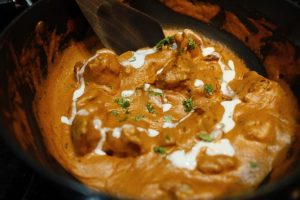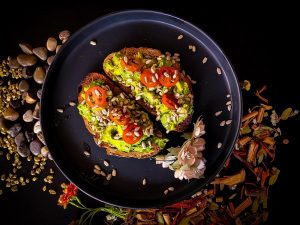The Sichuan peppercorn is the berry of a small, deciduous tree called hua jiao (Zanthoxylum simulans), which has a prickly trunk and grows 7-15 feet tall. The berries are harvested in July and August, when they are still green and unripe, then dried until they turn a dark brown.
In China, the berry is known as hua jiao (“flower pepper”), its name in Mandarin, or shan jiao (“mountain pepper”), its name in Sichuanese. English speakers often use the terms “Sichuan pepper” and “Szechwan pepper,” but neither is ideal. Not all of the world’s peppercorns come from Malabar. The term “Sichuan pepper” is confusing because it contains no pepper; it’s not a relative of Piper nigrum L., the plant that yields black, white, and green peppers. And because Sichuan is also spelled “Szechwan” or “Szechuan,” or even “Sishuan,” it’s easy to confuse the Sichuan region with its namesake peppercorn; some people think that Szechwan cuisine should be spiced primarily with Szechwan pepper.
The Sichuan peppercorn is the outer pod of the tiny fruit of a number of species in the genus Zanthoxylum (most commonly Z. simulans), widely grown and consumed in Asia as a spice. The genus contains about 250 species, and has a cosmopolitan distribution throughout the temperate and subtropical regions of the world.
The Sichuan peppercorn is known in Chinese as huā jiāo (花椒/花椒; Mandarin; literally “flower pepper”). It is also known as Chinese coriander, (香菜, “fragrant vegetables”), (lit. “sichuan pepper”), or (lit. “sichuan cinnamon”). In Korean, it is called chopi (초피). In Japanese, it is called sanshō (山椒). In Bhutan, it is called thingye. Its Tibetan name is yer ma.
Sichuan peppercorn is a relatively new find in the West. It is not peppercorn at all, but the dried berry of a tree related to citrus. In Chinese it is called hua jiao, or “flower pepper,” because its aroma is reminiscent of flowers.
Sichuanese use it in generous quantities as both spice and herb. It has an unusual taste, more tangy than spicy and numbingly powerful. Western recipes often call for a light touch, but in China the flavor of Sichuan peppercorn is one of the distinguishing features of the food.
Its first use was probably not culinary. Like many spices, the fresh berries were used medicinally, to treat intestinal parasites and indigestion. The earliest recorded use was in third century B.C., when it was prescribed in a herbal remedy book.
Sichuan peppercorns, also known as Szechwan peppercorns or Szechuan peppercorns, are a spice commonly associated with the cuisine of China’s Sichuan province and probably date back to the end of the Han dynasty (220 AD). Today, they are used in Chinese cuisine and also in neighboring Asian countries including Nepal, Bangladesh and Japan.
Sichuan peppercorn is not related to black pepper or chili pepper. It is actually the husk of a tiny fruit that closely resembles juniper berries. At one time it was believed to be a close relative of ash berries. More recently, however, botanists have concluded that it is closely related to prickly ash.
The outer shell of sichuan peppercorn can be shiny red or brownish, while its inner seed can be black or reddish-brown. The spice is most commonly sold as whole dried husks, although powdered versions are available as well. When used in cooking, the outer shell of sichuan peppercorn should be removed and only the seed should remain.
Sichuan peppercorn has a unique flavor unlike any other spice. It has both lemony and woody qualities with a slight numbing effect on the tongue similar
Sichuan peppercorns are a spice used in the Sichuan cuisine of China’s southwestern Sichuan Province. It is derived from at least two species of the global genus Zanthoxylum, including Z. simulans and Z. bungeanum.
The botanical name comes from Greek ξανθός (xanthos), meaning “yellow”, and ξένον (xenon), meaning “strange”. The name was given by a Greek botanist, P. B. Webb, in 1851. In Chinese, the name means “flower pepper” (), due to the shape and colour of the fruit, which resembles pepper grains.
Sichuan peppercorns have an intensely fragrant, citrus-like flavour with slight lemony overtones. They are not as pungent or tongue-numbing as black or white peppercorns, but produce a tingling numbness in the mouth that sets the stage for hot spices. Peppercorns can be chewed raw to release their flavour, but are most commonly used dried and lightly crushed to add fragrance to meat and vegetable dishes such as mapo tofu or gong bao chicken (also known as kung
Sichuan peppercorn is a misnomer, since it is not actually related to pepper. Nor is it related to the prickly ash shrub, which also goes by the common names of Sichuan pepper, Chinese pepper and sansho (Japanese).
Sichuan pepper has a unique aroma and flavour that is not hot or pungent like black, white or chili peppers. Instead, its “heat” seems to come from tiny hydro-carbon needles that stimulate the nerves responsible for detecting heat (capsaicin) and cold (menthol). The tongue-numbing sensation can be quite powerful in some varieties.
The very best of these are made into Zanthoxylum bungeanum tea or “tingly tea.” The leaves have been described as tasting like grapefruit rind with a hint of cinnamon.
When consumed with other spices, particularly chilli peppers, they produce a strange tingling numbness that sets the mouth aglow and most people find pleasant.
The raggedy little balls of schizocarp, which come from a family of trees that includes citrus, look less like peppercorns than allspice. But in the mouth they release a penetrating, almost medicinal sensation that is at once hot and numbing. A chemical called hydroxy alpha sanshool is to blame, and the effect is like putting benzocaine on your tongue. Sichuan peppercorns are often used in combination with fresh or dried chilies (the hotter the better) to create ma la: a searing, tongue-numbing heat that can be so intense as to make one’s eyes water and nose run uncontrollably. The Chinese call this phenomenon ma (meaning “numbing”) and la (“hot”).
The spiciness of Sichuan cuisine owes much to the region’s geography: The province lies within the tropics and is dominated by high mountains. This has produced many varied microclimates and terroirs, including some that are relatively cool and humid, which are ideal for growing chili peppers; they grow wild throughout the region.
The use of Sichuan peppercorn in combination with chili peppers originated in southwestern China during the late Ming Dynasty (1368–1644). It

